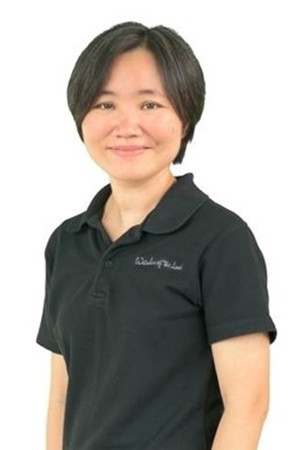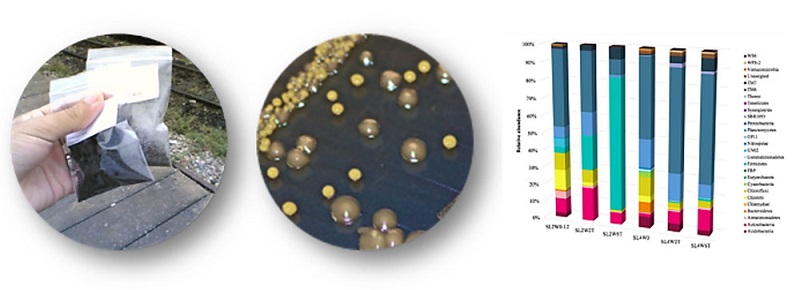IMB Lab
Industrial Microbiology & Biotechnology (IMB) Laboratory.

Assoc.Prof. Thunyarat Pongtharangkul
- Tel. (66+)086-379-7037
- e-mail : thunyarat.pon@mahidol.ac.th
- Location: R3/6 SC3 Bldg., Salaya Campus, Faculty of Science, Mahidol University

Our expertise includes isolation of bacteria from biological samples (e.g. food, soil, wastewater, biofilm). Pure culture of each isolate can be identified to species level using 16s rDNA sequencing with necessary biochemical tests (depending on the species of interest). Number of viable cells and spores in the sample can be quantified using a spread plate technique. In case that the microbial populations (microbiome) is of interest, a culture-independent analysis using Next-generation sequencing (NGS) can be employed. This technique allows for discovering of microbes that are ‘non-culturable’ or may be in relatively low abundance and therefore ‘not detectable’ using traditional methods.
- Isolation of bacteria from biological sample (12,000 THB/sample)
- Identification and characterization of bacterial isolate using 16s rDNA sequencing and biochemical tests (2,100 THB/isolate)
- Quantification of bacterial viable cell and/or endospore in biological sample (600 THB/sample)
- Evaluation of bacterial community (microbiome) in biological sample using Next Generation Sequencing (NGS) (18,000 THB/sample
Our publications:
- Wongbunmak A, Khiawjan S, Suphantharika M, Pongtharangkul T. BTEX- and naphthalene-degrading bacterium Microbacterium esteraromaticum strain SBS1-7 isolated from estuarine sediment. Journal of Hazardous Materials 2017;339:82-90.
- Khiawjan S, Suphantharika M, Pongtharangkul T. 2014. Isolation of BTEX degrading bacteria from petroleum contaminated seabed sludges. Proceedings of the 2nd ASEAN Plus Three Graduate Research Congress (2nd AGRC), February 5-7. Bangkok, Thailand.
- Leiim J, Suphantharika M, Pongtharangkul T. 2015. Isolation and characterization of xylenes degrading-bacteria, Pseudomonas citronellolis PC1. Proceedings of The 27th Annual Meeting of the Thai Society for Biotechnology and International Conference, November 18-19. Bangkok, Thailand.
- Prasitwuttisak, W, Sapsanyakorn, K, Ruanglek, V and Pongtharangkul, T. (2018) A study on effects of 1,3-butadiene exposure on bacterial community in activated sludge using next generation sequencing. The 186th The IIER International Conference, 26-27 August 2018, Taipei, Taiwan.

We have experiences on extraction and quantification of hydrocarbons (in liquid and gas phase) using chromatography techniques. Biodegradation test using either a pure bacterial culture or natural consortium can be performed in parallel with an appropriate control experiment in order to evaluate the potential or efficiency of the culture/consortium of interest. An ability of the culture/consortium to form biofilm on various solid supports can be evaluated in order to support the decision making on the supporting material. The structure of the biofilm of interest can be visualized using a scanning electron microscope (SEM).
- Biodegradation test for hydrocarbons (12,000 THB/sample)
- Biofilm formation test (6,000 THB/sample)
- Determination of biofilm structure using SEM (18,000 THB/sample)
Our publications:
- Wongbunmak A, Khiawjan S, Suphantharika M, Pongtharangkul T. BTEX- and naphthalene-degrading bacterium Microbacterium esteraromaticum strain SBS1-7 isolated from estuarine sediment. Journal of Hazardous Materials 2017;339:82-90.
- Khiawjan S, Suphantharika M, Pongtharangkul T. 2014. Isolation of BTEX degrading bacteria from petroleum contaminated seabed sludges. Proceedings of the 2nd ASEAN Plus Three Graduate Research Congress (2nd AGRC), February 5-7. Bangkok, Thailand.
- Leiim J, Suphantharika M, Pongtharangkul T. 2015. Isolation and characterization of xylenes degrading-bacteria, Pseudomonas citronellolis PC1. Proceedings of The 27th Annual Meeting of the Thai Society for Biotechnology and International Conference, November 18-19. Bangkok, Thailand.

Our lab focuses on the utilization of biocatalyst, including a crude enzyme extract, purified enzyme and whole-cell, for environmental friendly and sustainable production of bio-based chemicals. The target compound-of-interest can be extracted from the reaction mixture or biological sample, and then identified/quantified using various chromatography techniques.
- Extraction of target compound in biological sample (3,600 THB/sample)
- Identification of target compound in biological sample using chromatography techniques (15,000 THB/sample)
- Quantification of target compound in biological sample using chromatography techniques (2,400-5,400 THB/sample)
Our publications:
- Wangrangsimagul N, Klinsakul K, Vangnai AS, Wongkongkatep J, Inprakhon P, Honda K, Ohtake H, Kato J, Pongtharangkul T. Bioproduction of vanillin using an organic solvent-tolerant Brevibacillus agri Applied Microbiology and Biotechnology 2012 Jan;93(2):555-63.
- Siriphongphaew A, Pisnupong P, Wongkongkatep J, Inprakhon P, Vangnai AS, Honda K, Ohtake H, Kato J, Ogawa J, Shimizu S, Urlacher VB, Schmid RD, Pongtharangkul T. Development of a whole-cell biocatalyst co-expressing P450 monooxygenase and glucose dehydrogenase for synthesis of epoxyhexane. Applied Microbiology and Biotechnology 2012 Jul;95(2):357-67.
- Sungwallek S, Payongsri P, Chaiyen P, Pongtharangkul T. 2016. Development of a whole-cell biocatalyst for caffeic acid production. Proceedings of The 28th Annual Meeting of the Thai Society of Biotechnology and International Conference, November 28-30. Chiang Mai, Thailand.

Our expertise includes cultivation of natural and recombinant bacteria (or yeast) for production of cell, endospore as well as target product (e.g. alcohol, organic acid, protein). Fed-batch and repeated-batch cultivation can also be employed for higher productivity.
- Bioreactor cultivation conditions for maximum productivity (18,000-30,000 THB/batch)
Our Publications:
- Pongtharangkul T, Chuekitkumchorn P, Suwanampa N, Payongsri P, Honda K, Panbangred W. Kinetic properties and stability of glucose dehydrogenase from Bacillus amyloliquefaciens SB5 and its potential for cofactor regeneration. AMB Express 2015; 5;68.
- Suwanpatcharakul M, Pakdeecharoema C, Visuttitewina S, Pesirikan N, Chauvatcharin S, Pongtharangkul T. Process Optimization for an industrial-scale production of Diphtheria toxin by Corynebacterium diphtheriae PW8. Biologicals 2016; 44(6):534-9.


